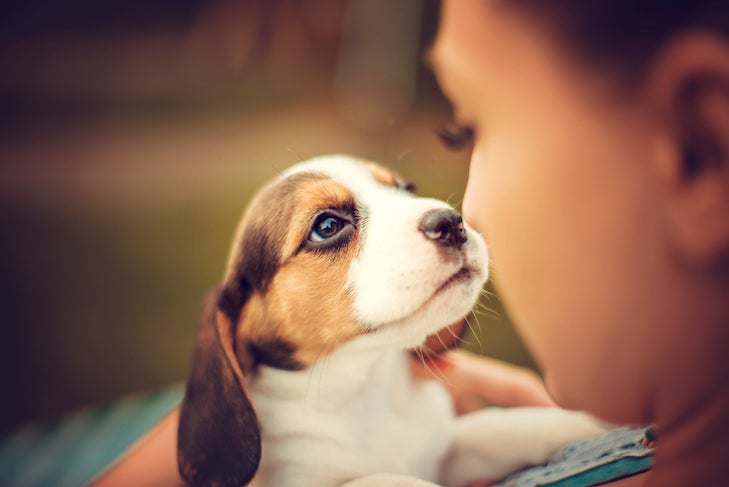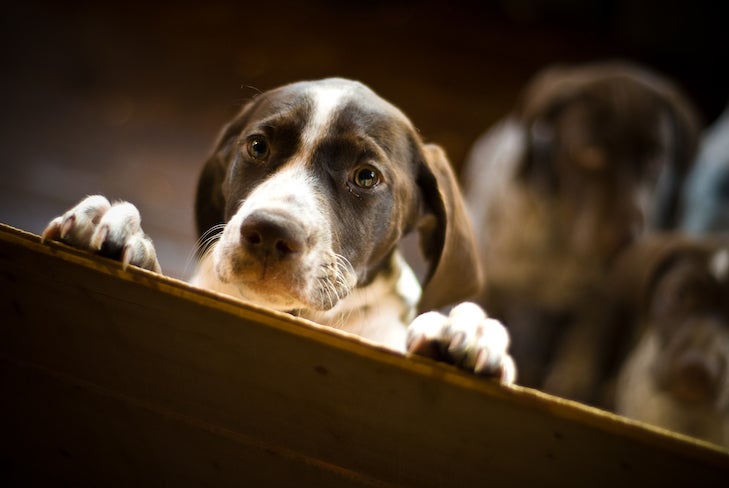
Every dog lover knows the telepathy between man and his best friend: that doggy sixth sense that has them loving on you when you’re sad and even seeming to anticipate your commands. But how did dogs get to be so excellent at communicating with people in the first place?
Putting Puppies’ Communication Skills to the Test
A new study from the Arizona Canine Cognition Center at the University of Arizona has answers. For the study, which was funded in part by the AKC Canine Health Foundation, researchers put 375 eight-week-old puppies through four tests, designed to establish whether even such tiny pups were receptive to human communication. Crucially, these dogs had never spent a significant amount of time with humans before: in training to be Canine Companions service dogs, they had spent their two months of life cuddled up with their mothers and fellow puppies.
The hypothesis was that if dogs this young and with this little exposure to humans were able to tune in to human communication, that communication must come hardwired, instead of being learned.
So could they? In a word: yes.
First, researchers tasked the puppies with finding a treat hidden in a cup (having made sure both cups smelled of treats, so the pups couldn’t just follow their noses). They found that the dogs were able to follow both human pointing and humans placing a yellow block near the correct cup, finding the treat an average of 67 percent of the time for both tasks—significantly more than the 50 percent you’d expect by pure chance. Each dog completed each task 12 times, and the researchers found that they did not improve over the course of the trials, further confirming that this behavior is not learned but innate.
Next, researchers ran two tests to find out how likely puppies are to make eye contact with humans or gaze at their faces. Their first question: How likely are they to gaze at us when prompted? Researchers spoke to the pups in “dog-directed speech”—essentially baby voice—for 30 seconds, and found that the puppies made eye contact with them for six of those 30 seconds, suggesting that they really were interested in the researchers’ attempts to communicate with them. Earlier studies have shown that older dogs pay even more attention to dog-directed speech, suggesting that while this interest is innate, it’s also something dogs learn to engage in more as they get older.
Finally, they tested how likely dogs are to engage humans of their own accord, through a test known somewhat dauntingly as the “unsolvable task.” The puppies were given a treat sealed in a transparent box, and monitored as they tried to access it. Earlier tests have shown that while wolves do not look to humans for guidance in this situation, adult dogs do. These itty bitty puppies were somewhere between those extremes: “They do make eye contact, but only for about a second, over the 30-second trial,” says Dr. Emily E. Bray, the study’s lead author. “So the tendency you could say is there, it’s present, but it’s not very strong at all.” Bray compares this tendency to human children, who are receptive to adult guidance from a very young age, but take longer to seek it out independently.

So: Were Dogs Bred To Converse With Humans?
It’s an age-old question: Just how did dogs get to be so well suited to human companionship and communication? While it’s long been reasonable to assume that earlier humans selected and bred dogs for their communicative abilities, this new research is a vital new piece in the puzzle.
Crucially, the researchers didn’t stop at studying the puppies’ average abilities—they also studied each puppy’s individual abilities, using the detailed genetic history available from Canine Companions. That leg of the study revealed that any given dog’s communication skills are up to 40 percent heritable from their parents and lineage—an extremely high rate for a heritable trait.
Given all this, it’s not so hard to see how dogs became man’s best friend. “I think it definitely suggests that their receptivity to our social signals is something that probably was selected for over the course of domestication,” Dr. Bray told me. “That it’s something that has evolved over time.”
Canine Super-Communicators: The Dogs of the Future?
It seems likely that our ancestors bred highly communicative dogs partly for work roles like hunting and herding, which rely on their being highly attuned to human commands and behavior.
Today, there’s less demand for hunting and herding dogs, but this research still has a highly valuable application. The puppies tested were bred by Canine Companions to be service dogs—and yet, as Dr. Bray told me, “Probably only 50 to 60 percent of them will be successful.” Since communicating with humans is at the core of service dogs’ work, being able to breed for communication skills could someday help Canine Companions and similar organizations to provide more highly communicative pups to people in need.
There’s still more research to do: having discovered that this trait is heritable, Dr. Bray and her colleagues are now trying to establish exactly how it’s inherited. Which genes is it coded into? That information will give breeders of service dogs and companion pets alike a much greater ability to select highly communicative dogs for breeding.
Until then, there’s always the old-fashioned method, which so many generations of humans seem to have used before us: befriending and breeding those pups who seem to understand what we say, as if by magic.

